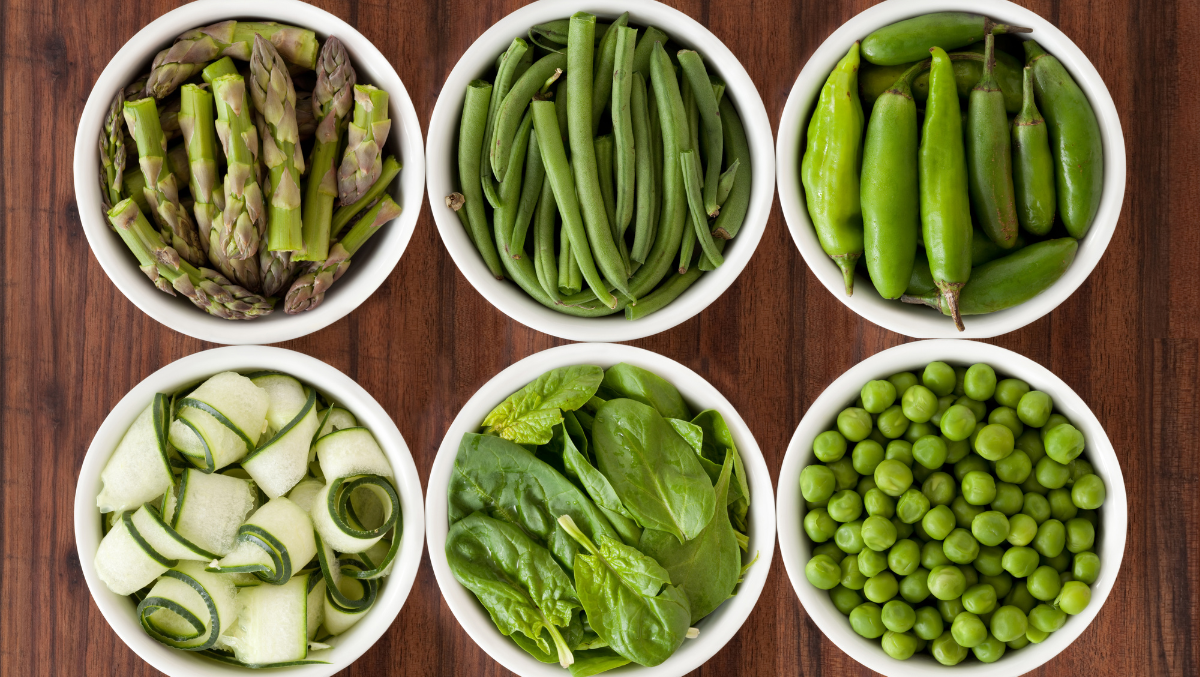In today’s world, where people are increasingly conscious about health and wellness, the demand for nutritious, natural ingredients is on the rise. Green fruits and vegetables have always been recognized as a vital component of a healthy diet due to their high nutritional content. However, incorporating fresh greens into products can be challenging due to their perishable nature. This is where green dehydrated vegetables come in. They offer an excellent alternative for product development by providing all the nutrients of fresh greens but with a longer shelf life.
In this article, we will explore the power of green dehydrated vegetables and how they can benefit product development for research and developers (food scientists) and ingredient purchasers.
The Importance Of Green Vegetables for the Consumer
For research and developers (food scientists) and ingredient purchasers, knowing what the nutritional value your consumers expect in products that use green vegetables is helpful when developing new products or selecting ingredients for existing ones. As a healthy and natural source of vitamins, minerals, fiber, and antioxidants, green vegetables offer numerous health benefits such as preventing chronic diseases like diabetes, heart disease, and cancer. The high fiber content in green vegetables also promotes gut health and aids in digestion. Your consumer expects these nutritional outputs
Benefits of Green Dehydrated Vegetables
Green dehydrated vegetables offer the same nutritional benefits as fresh green vegetables. They are a convenient, shelf-stable option that can be easily incorporated into meals or snacks. Dehydration preserves the nutrients in the vegetables and removes the water content, resulting in a concentrated source of vitamins, minerals, fiber, and antioxidants. Additionally, dehydrated greens have a longer shelf life than fresh greens and can reduce food waste. Overall, incorporating green dehydrated vegetables into diets or products is an easy way to add nutrition and convenience to healthy eating habits.
Incorporating Greens Into Daily Diets
When incorporating green vegetables into daily diets, consumers expect to receive a wide range of health benefits. Green veggies are known for being high in nutrients such as vitamins, minerals, fiber, and antioxidants that help prevent chronic diseases. Consumers also expect green vegetables to promote gut health, aid in digestion, boost the immune system, and help manage weight by providing low-calorie options that keep them feeling full.
For research and developers (food scientists) and ingredient purchasers, it’s important to note that incorporating green vegetables into food products can add nutritional value while enhancing flavor and texture. Green veggies can be used in various forms such as purees or powders to create innovative food products that meet consumer demands for healthy and tasty options. By incorporating greens into their food products, researchers and developers can create healthier options for consumers without sacrificing taste or texture.
What Green Vegetables are Good For
Nutrient-rich greens in food products make healthier end products for consumers that promote overall well-being. Greens such as kale, spinach, and cabbage into foods like salads, smoothies, and sandwiches, individuals can increase their intake of essential vitamins and minerals that are important for maintaining good health. Not only do these greens provide numerous health benefits, but they also add a delicious flavor and vibrant color to meals.
Nutritional Breakdown Of Various Green Vegetables
Understanding the nutritional breakdown of various green vegetables is crucial for creating healthier end products that meet the needs of today’s health-conscious consumers. Here are a few green vegetables:
- Spinach: A nutrient powerhouse, spinach is rich in vitamins A, C, E, K, and folate. It also contains iron, magnesium, calcium, and potassium.
- Kale: Another leafy green that is packed with nutrients, kale is an excellent source of vitamins A, C, K, and B6. It also contains minerals such as calcium and potassium.
- Broccoli: This cruciferous vegetable is loaded with vitamins C and K as well as folate and fiber. Broccoli also contains compounds called sulforaphane and indole-3-carbinol which have been linked to numerous health benefits.
- Chives: Chives are a nutrient-dense herb that adds flavor to various dishes. One tablespoon contains only 1 calorie, making it an excellent option for those watching their calorie intake. Chives are rich in vitamins A and K and are a good source of antioxidants such as quercetin. They also contain small amounts of minerals like calcium, iron, and potassium.
- Cabbage: Cabbage is a cruciferous vegetable that has many health benefits. It’s low in calories with only 22 calories per cup and high in fiber and water content. Cabbage is rich in vitamins C and K and contains antioxidants such as anthocyanins and sulfur compounds.
- Zucchini: Zucchini is a versatile vegetable that can be used in many recipes. It’s low in calories with only 20 calories per cup and high in water content and fiber. Zucchini is rich in vitamins C and B6 and contains minerals like potassium and manganese.
- Peas: Peas are a legume that can be eaten fresh or dried. They’re low in calories with only 62 calories per cup but high in protein and fiber. Peas are rich in vitamins A, C, K, and B6 while also being a good source of minerals like iron, magnesium, and phosphorus.
By incorporating these nutrient-rich greens into food products or purchasing them as ingredients for recipes, research and developers can create healthier end products for consumers that promote overall well-being
Dehydrated Greens and Fiber
Fiber plays a crucial role in maintaining a healthy diet as it helps regulate digestion, supports heart health, controls blood sugar levels, and aids in weight management.
The amount of fiber that dehydrated vegetables add to a final product varies depending on the type of vegetable and the amount used. In general, dehydrated vegetables can provide a significant amount of fiber per serving, with some types containing up to 5 grams of fiber per ounce. However, it’s important to note that the dehydration process can also concentrate other nutrients and minerals in the vegetables, so they can still be a nutritious addition to a final product.
Famous Microgreens
Microgreens are young vegetable greens that have gained popularity in the food industry due to their high nutritional value and versatility in cooking. As a research and development team or ingredient purchaser, it’s important to note that these tiny greens contain up to 40 times more nutrients than their mature counterparts, making them a highly sought-after ingredient for health-conscious consumers.
Microgreens can be grown from a variety of vegetables using soil or soil substitutes such as coconut coir or peat moss. They are typically harvested when they reach a height of 1-3 inches, and can be used as an ingredient in a wide range of dishes, including salads, sandwiches, smoothies, and more.
In addition to their nutritional benefits, microgreens add texture and flavor to dishes, making them a valuable ingredient for food scientists looking to create innovative and healthy products. Whether you’re growing microgreens in-house or purchasing them from a supplier, incorporating these tiny greens into your products is sure to appeal to health-conscious consumers looking for nutrient-dense options.
Popular Microgreens and their Nutritional Value
Some of the most common types of microgreens include kale and broccoli.
- Kale is a popular choice for health-conscious consumers. Its versatility makes it easy to incorporate into meals such as salads, smoothies, stir-fries or even baked chips.
- Broccoli sprouts are packed with nutrients. Its versatility makes it easy to incorporate into various products, such as stir-fries, salads, or soups.
How to Incorporate Microgreens into the Product Development Process
Incorporating microgreens into the product development process can add both nutritional value and flavor to a wide range of food products. Here are some ways you can incorporate microgreens into your product development process:
- Experiment with different varieties: Purchase different types of microgreens to see which ones work best in your products. Consider factors such as flavor, texture, and nutritional content when selecting which microgreens to use.
- Add them to salads products: Microgreens are a great addition to salad products, adding both flavor and texture. Consider incorporating them into pre-packaged salads or sandwich kits for an added boost of nutrients.
- Blend them into smoothies: Adding microgreens to smoothies is an easy way to boost a product’s nutritional content of the drink while also adding flavor. Consider using mild-flavored greens like spinach or kale for a more palatable taste.
- Incorporate them into sauces and dressings: Microgreens can be blended into sauces and dressings for added flavor and nutrition. Consider using herbs like basil or cilantro for added freshness.
By incorporating microgreens into your product development process, you can create innovative and healthy products that appeal to health-conscious consumers looking for nutrient-dense options.
Boost Product Health and Flavor with Green Dehydrated Vegetables
Green dehydrated vegetables are a nutritious addition to any product development cycle, and incorporating them into meal creation can have numerous health benefits. These vegetables are packed with essential vitamins and minerals, such as vitamin C, iron, and potassium, which can help boost immunity and promote overall wellness. Additionally, green dehydrated vegetables offer a long shelf life, making them an ideal ingredient for food manufacturers.
For food scientists and ingredient purchasers in particular, green dehydrated vegetables offer a versatile ingredient option that can be incorporated into a wide range of products. From snacks to soups to seasoning blends, these nutrient-packed veggies can add both flavor and nutrition to any dish.
So if you’re looking for a way to enhance the nutritional value of your product, consider adding green dehydrated vegetables to your ingredient list. Consumer taste buds (and body) will thank you!


